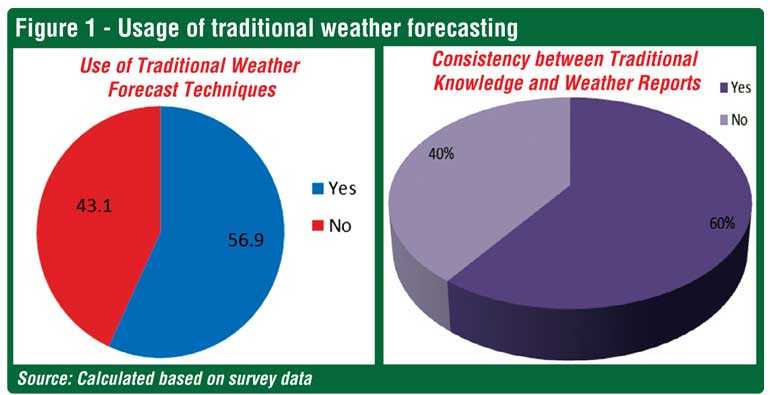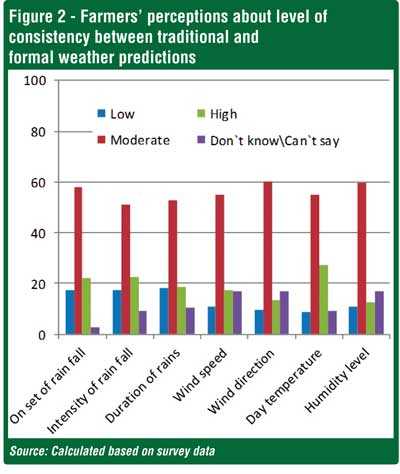Saturday Feb 22, 2025
Saturday Feb 22, 2025
Tuesday, 17 July 2018 00:00 - - {{hitsCtrl.values.hits}}

By Dilani Hirimuthugodage
“If eagles and grey hornbills are fl ying above their normal height in the sky, it signals that rain is expected soon; if seagulls are flying close to the ground, it suggests that there will be heavy rainfall. However, these patterns have now changed because of the development activities in the Lunugamwehera Tank, Bundala Salt Corporation, etc.,” said Bandara, a 60-year-old paddy farmer from Bundala, in Hambantota District.
ying above their normal height in the sky, it signals that rain is expected soon; if seagulls are flying close to the ground, it suggests that there will be heavy rainfall. However, these patterns have now changed because of the development activities in the Lunugamwehera Tank, Bundala Salt Corporation, etc.,” said Bandara, a 60-year-old paddy farmer from Bundala, in Hambantota District.
He attended the Participatory Rural Appraisal (PRA) programme of a research study conducted by the Institute of Policy Studies of Sri Lanka (IPS), and other partner institutes.
Bandara possesses what is known as traditional or indigenous knowledge. Traditional knowledge is awareness among lay people and their understanding of the structure or the system, which is generally passed on from one generation to the other, usually by word of mouth, observations, and practices. This knowledge is specific to countries, areas, or communities, due to varying environmental and social conditions.
Like Bandara, most farmers in Sri Lanka use techniques inherited from their ancestors to identify seasonal variations and predict weather patterns. Yala (May-August) and Maha (September-March) seasons were established based on such knowledge and observations. They used to start their cultivation based on these recognised local patterns and predictions which have usually been accurate.
Farmers’ use of traditional knowledge on climate
A survey carried out by IPS in six districts in Sri Lanka (Anuradhapura, Batticaloa, Hambantota, Kurunegala, Badulla and Ratnapura), interviewed 900 farmers, using a semi-structured questionnaire. Nearly 57% of the farmers said they use traditional weather forecasting methods or their traditional knowledge in making crop cultivation decisions, while 43% of them stated that they do not use traditional methods (Figure 1). Furthermore, 60% of the farmers who are using traditional methods claimed that their predictions are consistent with the formal weather report predictions (Figure 1).
Around 60% of farmers perceived that traditional weather forecasts are moderately consistent with formal weather predictions relating to parameters concerning the onset of rain fall, intensity of rain fall, duration of rains, wind speed, wind direction, day temperature, humidity level, etc. (Figure 2).

Traditional knowledge and weather predictions: Some observations
Participatory Rural Appraisal (PRA) sessions were conducted with farmers in six districts to explore the nature and use of traditional climate knowledge. Farmers who participated in PRA programs informed that they use observations on the changes in local environment such as animal behaviour, blossoming of certain trees (mostly indigenous trees), appearance of various insects, and changes in cloud patterns and wind, etc. to take decisions regarding agricultural practices. Sometimes these practices vary from place to place within Sri Lanka. Box 1 highlights some of the local observations that constitute traditional climate knowledge as reported by farmers in PRA sessions.
Declining reliability of traditional climate knowledge and the role of scientific weather forecasts
Farmers also observed that with the recent changes in global climate and local environments, their local predictions have become less reliable. They reported that, in the past, their predictions based on traditional knowledge have been accurate to a great extent.
However, the situation has changed recently. Farmers in all districts complained that familiar patterns of local climate have changed significantly. Some farmers directly linked it to ‘global climate change’ of which they became aware from various sources such as the media. Their accounts confirm that climate change is already taking place in local areas.
Moreover, it is evident that with the process of development, several environmental changes have also occurred. Infrastructural projects and construction of physical structures which are designed to make human life easier have changed the natural environment in local areas.
Farmers explained that in some areas, traditional signs and indicator species of plants and animals that used to predict changes in climate are not easily visible due to local environmental changes. As a result, present day farmers find it difficult to predict climatic events using their traditional knowledge. In spite of this situation, a significant number of farmers still continue to use local knowledge to a certain extent even though they find it increasingly less reliable.
Therefore, it is evident that farmers may not be able to rely only on their traditional knowledge as local climate patterns and environmental conditions have changed, and some of the traditional indicators that they used in the past are not available at present.
The best solution to overcome this challenge would be strengthening farmers’ decision making capacity by providing them with science–based climatic weather forecasts to complement their traditional knowledge in predicting climate changes. This will help to produce reliable results by harmonising farmers’ local climate and environmental observations with scientific climatic predictions. Presently, the Department of Meteorology is providing science based weather forecasts to selected farmer groups in six selected districts as a pilot study. The research emphasises the importance of providing weather forecasts focused at local levels rather than at district levels for higher accuracy, and also the importance of optimising the use of farmer’s traditional knowledge.
[Dilani Hirmuthugodage is a Research Officer at the Institute of Policy Studies of Sri Lanka (IPS). Contact the author on [email protected].]
Animal behaviour
Predictions are mainly based on the behaviour of birds.
“If eagles fly high in the sky, if there are more than two young crows in a nest, if owls make noise at night, and if weavers build nests in neem trees, rain will fall very soon,” claimed farmers from Kurunegala.
Farmers in Ratnapura and Anuradhapura districts also mentioned the same behavioural pattern of birds when predicting rainfall. Meanwhile, Batticaloa district farmers forecast environmental changes if birds fly in the same direction in groups.
Blossoming of trees
Farmers in all six districts use observations on budding and flowering of trees, especially in indigenous trees such as mora, palu and wood apple for local weather predictions.
“Palu trees covered with fruit indicate heavy rain fall. Normally, blossoming of Palu will happen in May. However, in 2017 there were ripe Palu even in December,” observed Hambantota district farmers.
“If there are more than an average number of fruits in mango trees, it indicates that there will be good rainfall for agriculture and we can harvest in both Yala and Maha seasons,” Kurunegala District farmers reported.
Cloud colour and cloud cover
Farmers in Sri Lanka also make climate predictions by observing patterns and colours of clouds.
“Dark, clustered clouds in August indicate that heavy rainfalls will occur shortly,” stated Kurunegala District farmers.
“Dark clouds around the moon foresee raining and also appearance of a rainbow is an indicator of future rain,” said Batticaloa District farmers. “Dark cloud cover in the months of July and August in the eastern side of sky predicts heavy rain in future. “When the east sky is dominated by red colour, it predicts heavy rains and it is a good start for a Maha season,” mentioned Anuradhapura District farmers.
Appearance of insects
Appearance of certain insects helps farmers predict weather changes.
“Meru flies appearing in November predicts the start of the rains for Maha season. If termites appear in rubber trees, it foretells rains,” informed Ratnapura District farmers.
There are some specific observations to identify seasonal variations. In the Kurunegala District, farmers believe that if rain comes between 10 and 15 October (called Akk Wessa), they could cultivate both Yala and Maha seasons successfully. Ratnapura district farmers too are concerned about wind speed and wind direction when predicting rainy seasons.
Discover Kapruka, the leading online shopping platform in Sri Lanka, where you can conveniently send Gifts and Flowers to your loved ones for any event including Valentine ’s Day. Explore a wide range of popular Shopping Categories on Kapruka, including Toys, Groceries, Electronics, Birthday Cakes, Fruits, Chocolates, Flower Bouquets, Clothing, Watches, Lingerie, Gift Sets and Jewellery. Also if you’re interested in selling with Kapruka, Partner Central by Kapruka is the best solution to start with. Moreover, through Kapruka Global Shop, you can also enjoy the convenience of purchasing products from renowned platforms like Amazon and eBay and have them delivered to Sri Lanka.
Discover Kapruka, the leading online shopping platform in Sri Lanka, where you can conveniently send Gifts and Flowers to your loved ones for any event including Valentine ’s Day. Explore a wide range of popular Shopping Categories on Kapruka, including Toys, Groceries, Electronics, Birthday Cakes, Fruits, Chocolates, Flower Bouquets, Clothing, Watches, Lingerie, Gift Sets and Jewellery. Also if you’re interested in selling with Kapruka, Partner Central by Kapruka is the best solution to start with. Moreover, through Kapruka Global Shop, you can also enjoy the convenience of purchasing products from renowned platforms like Amazon and eBay and have them delivered to Sri Lanka.